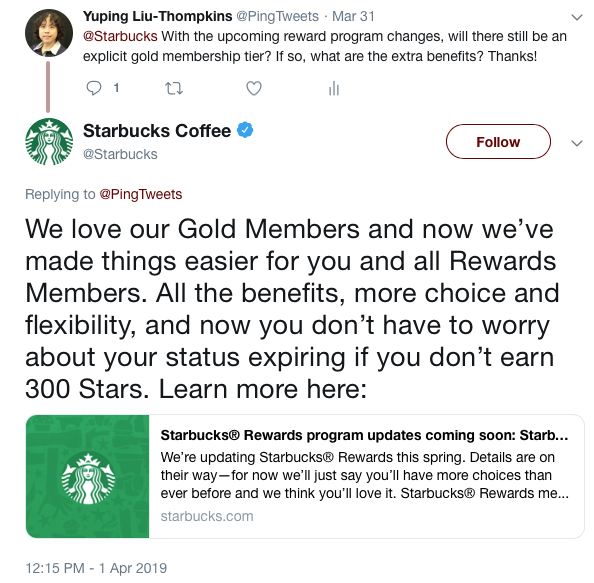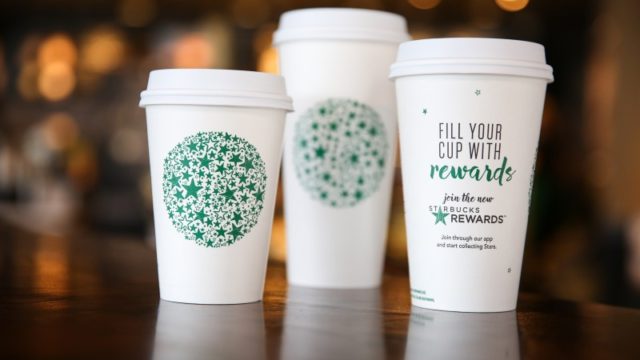Changes are coming to Starbucks Rewards. On April 16, Starbucks Rewards will be expanding its reward structure to five levels. A few other changes will be made to the program too. Will these changes make this leading loyalty program even better? What might be motivating these changes? How will the changes affect the program and its members? In this post, I attempt to dissect these changes and offer my assessment of the new Starbucks Rewards program design.
What Changes Exactly?
The biggest change to the program is the addition of more reward thresholds. Instead of a single reward threshold of 125 stars, it will feature five levels of rewards ranging from 25 to 400 stars. The new program will also erase the current difference between a Gold member and a base member, allowing both to enjoy the same set of benefits. The table below compares the current vs. the new program structure.
 | Current | From April 16, 2019 |
|---|---|---|
| Earning Stars | 2 stars per $ spent | 2 stars per $ spent (unchanged) |
| Reward Levels | A single level, at 125 stars | Five levels, at 25, 50, 150, 200, and 400 stars |
| Reward Items | A free food or drink item, excluding alcoholic beverages and multi-serve food and beverage items | 25 stars: free drink customization (e.g., extra shot, flavor, etc.); 50 stars: a free hot brewed coffee or tea, or a free bakery item; 150 stars: a free handcrafted drink, hot breakfast, or parfait; 200 stars: a free lunch sandwich, protein box, or salad; 400 stars: a free select merchandise (e.g., gift) or at-home coffee. |
| Membership Tier Structure | Green and gold. Gold is qualified by earning 300 stars in a 12-month period. | Single tier |
| Base Tier Benefits |
| Same as before, but now everyone has the same ability to redeem their earned stars for rewards. All members now also receive a monthly double-star day that used to be reserved for Gold members. |
| Gold Tier Benefits |
| Not applicable, as there will no longer be a premium tier. Gold members do not lose any benefits. They just have to share them with everyone else. |
| Star Expiration | 6 months after the star is earned | 6 months after the star is earned (unchanged) |
More Complex Reward Thresholds
The new design significantly expands the reward structure of the program from one to five levels. What could be driving this change?
Increasing Program Relevance
An attractive loyalty program should be relevant to consumers. If it takes too long to earn a reward, consumers may lose interest in the program. Assuming an average price of $2.5 for a tall coffee, the current threshold of 125 stars requires buying roughly 25 cups of coffee before one will receive a reward. The new program design rewards consumers at as low as 25 stars. For some, this level can be reached easily in one or two trips if you buy the more expensive items on the menu or if you buy for a group. For consumers who do not visit Starbucks all that often, the new design can be much more appealing to them. Even if someone goes to Starbucks only once a month or only buys black coffee, the consumer can still be rewarded for the effort in a reasonable amount of time. This increased relevance should attract the lighter buyers.
Inducing Habit
One of my earlier posts discussed research showing smaller but more frequent rewards are more conducive to developing habit than larger but less frequent rewards. The new Starbucks Rewards design does exactly that. Consumers can now get a treat much faster than before and can repeat that cycle over and over again in shorter time intervals. This can help promote the habit of buying from Starbucks. A counter force to this will be the very frequent program communication Starbucks seems to send out to its members these days. Habit needs to be reinforced through repetition and without much thinking. With each message, it is quite possible to jolt people out of their routine and break their habit. Therefore, the frequency and design of these messages will need to be carefully considered to avoid interference with the development of habit for some consumers.
Redirecting Redemption Behavior and Cost
With the currently undifferentiated rewards, many Starbucks Rewards members would redeem their free reward for the most expensive thing possible. I have actually had baristas suggesting that I order Venti instead of Tall and add yummy flavors to my free reward drink because…it would all be free! This policy blindly increases the reward cost. The new thresholds create a big gap among the different rewards. Getting a free Caramel Macchiato or Cinnamon Shortbread Frappuccino will now cost three times the number of stars for getting a Venti black coffee. The result? The impatient and instant-gratification-seeking members will likely just redeem for a regular cup of coffee or a flavor addition, significantly reducing the liability from rewards. For consumers who just want a healthy good ol’ cup of joe, they will be happy to get their free fix at a much sweeter star deal. Assuming an average of $2.5 for a regular hot brewed coffee, the new 50-star threshold is equivalent to 1 free coffee after 10 regular coffee purchases, as opposed to the current 1 free coffee after 25 cups of coffee.
Increasing Point Pressure
Psychology research shows that as we move closer to a goal, we are likely to work harder. Translated into loyalty programs, we often see a point pressure effect. As consumers get closer to a reward, they are likely to spend more or make another transaction faster in order to “get there”. In the current Starbucks Rewards program, that goal is 125 stars. In the new program, it will be 25, 50, 150, 200, and 400. This is like adding more mile markers to a race to make runners work hard toward that next target…“if only I can get past that next marker”. The redesign will make consumers sprint more frequently toward their reward goals, creating more opportunities for point pressure.
A downside, however, is that dividing a goal up into more sub-goals sometimes can make people be content with the lower goals (e.g., 50-star reward) rather than aiming for the highest goal possible (i.e., 400-star reward). But assuming those who settle on the lower goals will still want to do it over and over again, there is minimal loss for Starbucks and can actually save reward cost as I mentioned earlier.
No More Membership Tiers
*Starbucks’ announcement about the new design did not explicitly state a change in the program’s tier structure. So I tweeted to Starbucks and inquired about the change. Here’s the reply I received:

So it looks like the program is doing away with the tiers. This is not the first time Starbucks Rewards has tinkered with its member tier structure over its ten-year existence. I compiled below a timeline of the tier changes in Starbucks Rewards history:
 | November 2008 | Introduced Starbucks Gold Card. It charged a $25 membership fee and offered members one free drink and 10% off purchases. |
December 2009 | Starbucks Gold was folded into the combined My Starbucks Rewards program as the top membership tier, requiring 30 purchases to qualify and offering a free drink after every 15 purchases. Two other tiers existed below the Gold tier: a welcome tier that offered a free birthday beverage and two hours of Wi-Fi; and a green tier that required 5 purchases to quality and enjoyed the benefits of free refills, free flavors and soy, and a free drink with each 1lb whole bean coffee purchase. |
|
April 2016 | Starbucks Rewards simplifies to only two tiers, removing the previous welcome tier. Qualification and star earning changes from frequency based to spending based. Gold tier now required 300 stars ($150 in spending) to qualify. | |
April 2019 | Moving to a single-tier structure, no longer offering differentiated benefits across members. |
Going through this timeline, it appears that Starbucks Rewards had the full intention of creating a hierarchical program in its early days. However, over the years, it has gradually flattened the program structure from three tiers to two tiers, and now to the single-tier structure in this redesign. Two reasons may be behind this change:
One, it is not easy to create truly differentiated benefits among tiers in a coffee shop setting. In the current program, Gold members need to earn 300 stars (the equivalent of $150) to reach the tier. What do they get in return? Not a whole lot. Most of what they receive in addition to green-tier benefits are simply the right to spend more money and redeem those earned stars to redeem for rewards. One can say the return is quite meager compared with the effort, unlike the often coveted seat or room upgrades offered to premium members of travel loyalty programs. Without a way of making Gold members truly appreciated above and beyond an average member, the existence of a premium tier does not mean much in making people aspire for more.
Another reason for the flatter structure may be to appeal more to the general public. The new design removes the barrier to a higher tier and allows all consumers to earn rewards right from the beginning. It makes the cost of entry much lower, especially for consumers who currently do not spend that much at Starbucks. In combination with the low beginning reward threshold, the new program design will likely help the program expand in the lower spending segment and enroll more consumers in a would-be saturated market.
How will the flatter structure affect the cream of the crop consumers? There could be some negative impact there as these consumers will no longer be made special with their own tier. Although objectively speaking they are not losing any of their existing benefits, the psychological impact can still resonate. That is probably why Starbucks has been very indirect in talking about the new tier structure. The last thing they want to do is to alienate these best customers and tell them “you are no longer that important to us”. Regardless, some consumers will likely take offense. Only if Starbucks had been more creative in discovering the sweet spot of more distinctive benefits at a reasonable cost for the higher-tier members…
Overall Conclusion about the Starbucks Rewards Redesign
Taken together, I believe the new Starbucks Rewards design is intended to expand its member base and to more effectively target the lighter end of the customer spectrum. It is a growth-oriented strategy, which is likely a priority given Starbucks’ reported slower sales growth now that every street corner seems to have a Starbucks store. This goal of attracting lighter customers will likely be successful under the new design.
However, the long-term loyal customers of Starbucks may not feel particularly appreciated. Some of them may turn to the locally owned coffee shop across the street instead. The more complex program rewards together with frequent (in my opinion too frequent) bonus deals may also make the program more confusing to customers. Starbucks started as a higher-end coffee shop that served as a social and cultural gathering place for the community. I worry that the frequent bonuses Starbucks has been offering and will likely continue to offer will erode the perception of the brand in the long run. It may be trading long-term prosperity for short-term sales growth.
Ultimately, the balance between the good and the bad will determine whether Starbucks Rewards is headed for the better or worse with the upcoming changes.
